If you search the internet on best physics blogs, you can find a FeedSpot website listing the 60 Best Physics Blogs and Websites in 2024. There are perhaps some issues re paid promotion and the way the ranking is performed, and it only lists 30 websites. But it’s better than nothing. Top of the list is Physics World, which I talked about a few months ago. In second place is Sabine Hossenfelder’s now-lightweight Backreaction, and in third place is Quantum Frontiers, which is also lightweight. But in fourth place is the APS physics magazine, which is not:
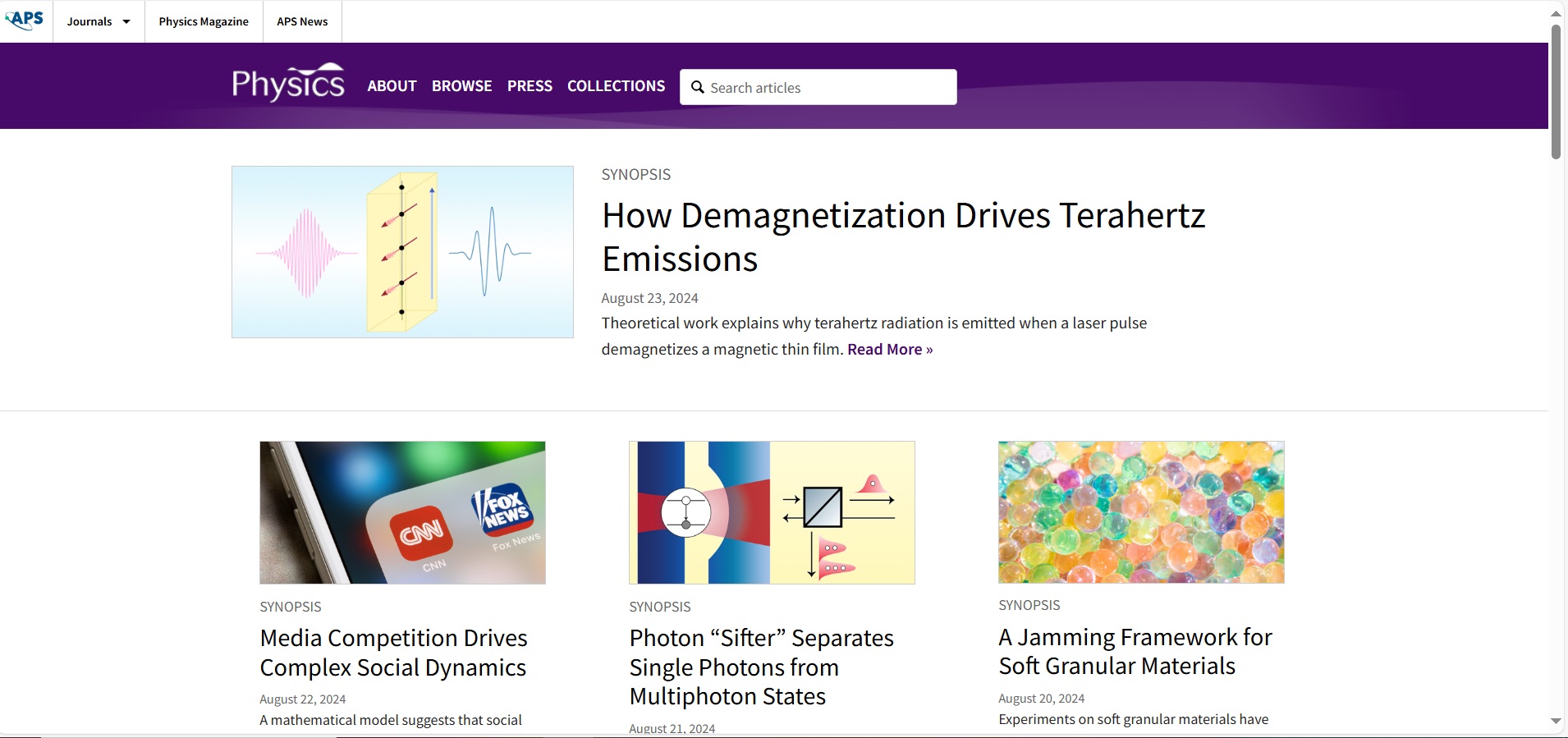 Screenshot from the APS Physics Magazine website
Screenshot from the APS Physics Magazine website
It’s a free online magazine which “primarily reports on papers from the Physical Review journals, focusing on results that will change the course of research, inspire a new way of thinking, or spark curiosity”. Hence I think it’s a good vehicle to see what’s been happening in physics of late. You can of course look at the journals themselves, but it’s a bit tricky because there’s 18 of them, and they’re paywalled. You may be able to find a paper on the arXiv if you search by author, or on ScI-Hub if you search using the DOI. The latter can be tedious because of the whack-a-mole way journal publishers manage to get Sci-Hub URLs closed down. In addition Sci-Hub doesn’t have a good hit rate for new papers. But nevertheless it can be useful, particularly for the unaffiliated. My personal view is that if research has received taxpayer funding, then taxpayers should not have to pay to read the results.
Early Galaxies Were Not Too Big for Their Britches After All
Anyway, if you scroll down the APS physics web page you can click on More Articles to see some selection criteria. Since my particular interest is fundamental physics and cosmology, I ticked a number of the boxes on the left, and then at the bottom specified a custom date range of 2024-01-01 to 2024-08-29*. This gave me 86 articles in all:
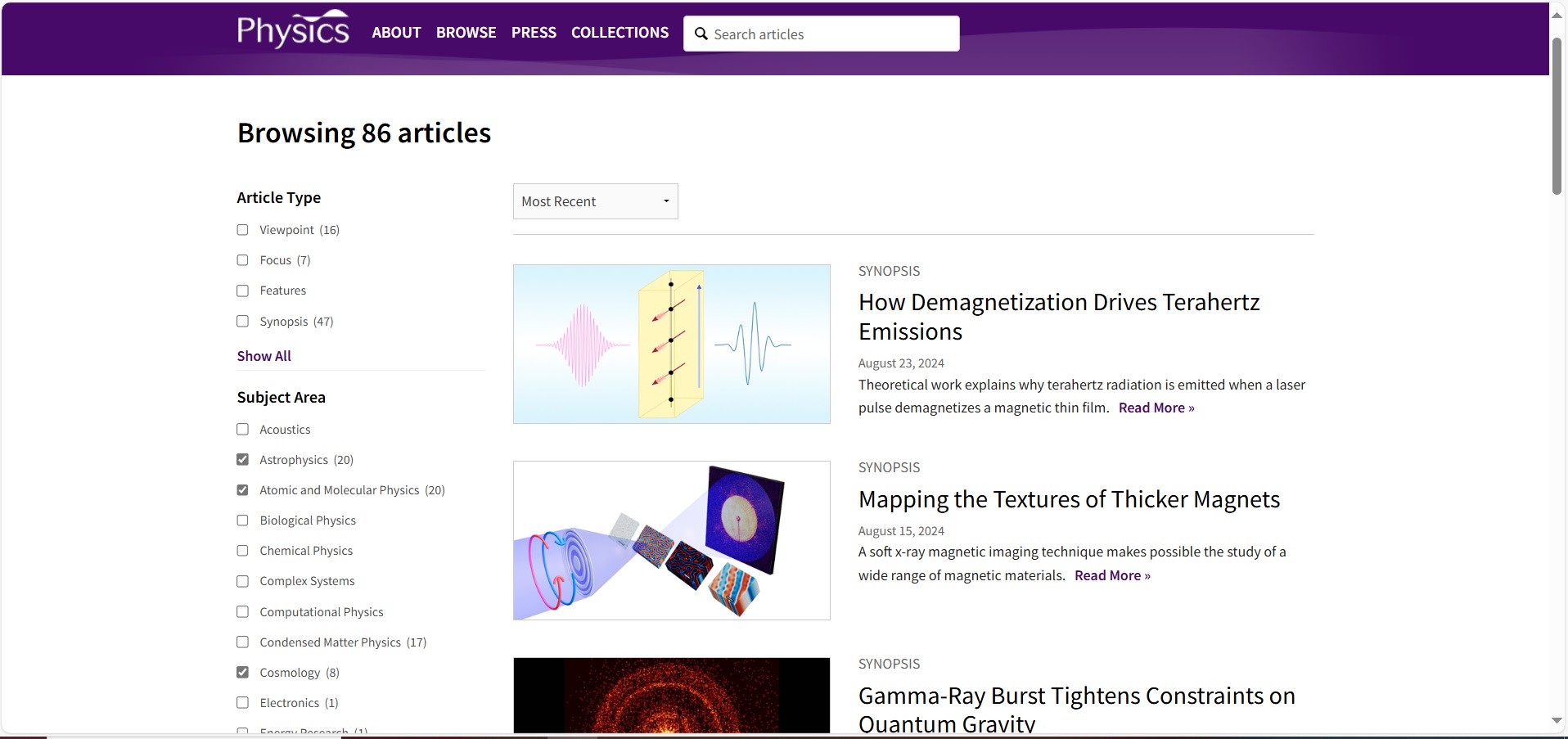 Screenshot from the APS Physics Magazine website
Screenshot from the APS Physics Magazine website
Not all of them were my cup of tea. For example How Migration May Stabilize the Diversity of Ecosystems isn’t fundamental physics. In fact I found myself checking the date, wondering if it was some AI-generated critical-race-theory spoof on how mass migration is good for you. On top of that there were some omissions, presumably because the website is primarily telling us about Physical Review research. For example there’s no mention of Early Galaxies Were Not Too Big for Their Britches After All. This was in my newspaper this week, and has obviously had a big press release. It’s an important subject, I’ll come back that another time.
How Demagnetization Drives Terahertz Emissions
For now check our some of the APS articles, such as How Demagnetization Drives Terahertz Emissions. It was written by Corresponding Editor Rachel Berkowitz. She tells how in 1996 physicists observed that “a thin film of ferromagnetic nickel loses its magnetization when irradiated by ultrafast laser pulses”. The article goes on to say “Jalil Varela-Manjarres and his colleagues at the University of Delaware now tie all these results together with a model that explains the details of the terahertz emission”. There’s a link to the paper, which you can also find on the arXiv. I read it with interest. To set the scene, the a magnetic field is present in the nickel film which is in contact with a nonmagnetic layer. The magnetic field is there because electrons have spin, and all the spins axes are lined up like little compass needles. An ultrafast laser pulse disrupts this so rapidly that there’s some kind of rapid snap change to the electromagnetic configuration. As a result light is emitted with a terahertz frequency, much higher than the laser pulse. It’s interesting stuff. However I ended up disappointed because the paper proposes a theory to explain what’s happening, and whilst it referred to Jefimenko’s equations, it talked about electric and magnetic fields as if they were totally separate things. It also talked about quantum transport theory, and charge and spin currents, but it didn’t refer to displacement current or to the screw nature of electromagnetism. It’s as if nobody has read what Maxwell said.
Mapping the Textures of Thicker Magnets
I felt the same about the next article, Mapping the Textures of Thicker Magnets. This time Rachel Berkowitz refers to work by Jeffrey Neethirajan and six other authors. Again the paper is on the arXiv. It’s experimental rather than theoretical, which I like. It tells how the team used used circularly-polarized soft X-ray light at the Diamond Light Source at Harwell to map out magnetic structures in various magnetic samples up to 1.7 µm thick. This is the important bit: “Circularly polarized x-rays interact differently with magnetic structures depending on their polarization direction – an effect called x-ray magnetic circular dichroism (XMCD). By comparing diffraction patterns obtained using each polarization direction, magnetic structures inside a sample can be mapped”.
S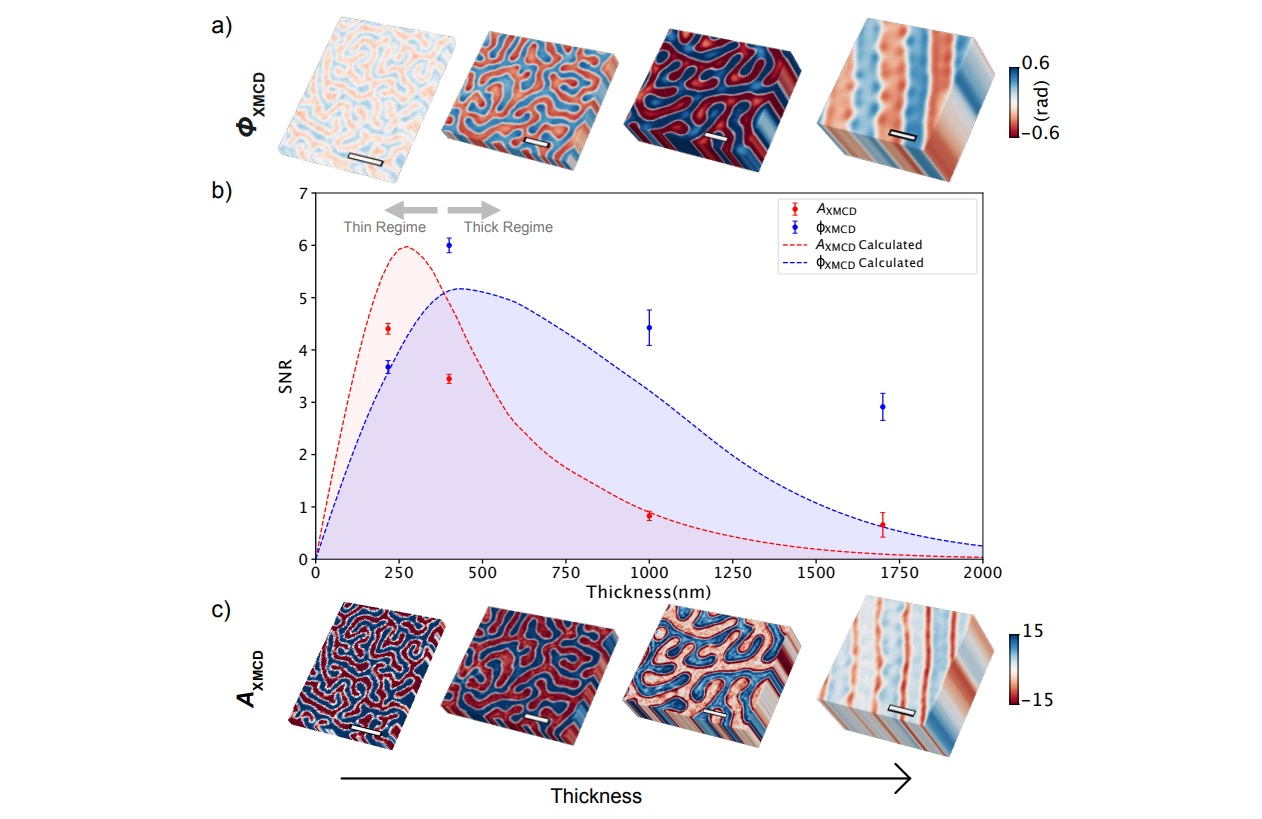 creenshot from Soft X-ray phase nano-microscopy of micrometre-thick magnets
creenshot from Soft X-ray phase nano-microscopy of micrometre-thick magnets
I think it’s good work, and I liked what it said about the study of materials critical to efficient and clean energy production. But there was nothing in there that gave any indication that the team knows how a magnet works. Knowing that is surely more important than imaging magnetic domains?
Gamma-Ray Burst Tightens Constraints on Quantum Gravity
The next article in my list was Gamma-Ray Burst Tightens Constraints on Quantum Gravity. It was written by Corresponding Editor Marric Stephens, who referred to a paper by the LHAASO collaboration called Stringent Tests of Lorentz Invariance Violation from LHAASO Observations of GRB 221009A. He came straight out with it, saying “An analysis of the brightest gamma-ray burst ever observed reveals no difference in the propagation speed of different frequencies of light – placing some of the tightest constraints on certain violations of general relativity”. He also said this: “Some theories of quantum gravity, however, predict that, for very high photon energies, a vacuum behaves like a medium”. That’s the medium like the glass in a prism, which refracts different frequencies by different amounts. However we don’t see any such frequency dispersion in gravitational lensing. I think that’s because the light path in glass is not linear, and is instead convoluted by subatomic particles, this varying with frequency. There is no similar effect in empty space. Again the paper is on the arXiv. , and again I think it’s good work. I like it because it undermines quantum gravity, which I think is based on a total lack of understanding of how gravity works. Especially the way the speed of light varies with gravitational potential. It’s as if nobody has read what Einstein said.
Entangled Photons Maintained under New York Streets
The next article in my list was Entangled Photons Maintained under New York Streets. It was written by Senior Editor Charles Day, who started by saying this: “A new scheme sends large numbers of entangled photons reliably through commercial fiber-optic cables, demonstrating a capability required for secure quantum networks”. He’s talking about a paper called Automated Distribution of Polarization-Entangled Photons Using Deployed New York City Fibers. It’s about the activities of a team led by a guy called Mehdi Namazi, the cofounder of New York start-up called Qunnect. Yet again the paper is on the arXiv. It says the distribution of high-fidelity high-rate entanglement over telecomms infrastructure is one of the main paths towards large-scale quantum networks, paving the way for quantum encryption and distributed quantum computing, amongst other things. It also says the team achieved end-to-end rates of nearly 5 × 10⁵ pairs per second, and an entanglement fidelity of approximately 99%. In addition it says they achieved 15 days of continuous distribution, with a network up-time of 99.84%.
 Image credit: tiero/stock.adobe.com. Caption: Quantum cable. A fiber-optic cable under New York City carried large numbers of quantum mechanically entangled photons with high fidelity, thanks to a system that continually compensates for disturbances of the photons’ polarizations.
Image credit: tiero/stock.adobe.com. Caption: Quantum cable. A fiber-optic cable under New York City carried large numbers of quantum mechanically entangled photons with high fidelity, thanks to a system that continually compensates for disturbances of the photons’ polarizations.
It sounds very promising, but when you read the paper carefully you see that their photons were emitted at different times from excited rubidium-87, one photon at 1324 nm, the other at 795 nm. That means they never met, and were not entangled. You also see that they were detecting polarisation dispersion rather than loss of entanglement. Regular readers will know my views on the overall subject: there is no quantum entanglement. There is no magic, there is no instantaneous action-at-a-distance, there are no higher dimensions. All there is, is the local polarizer rotates the local photon, such that cos² θ applies when photons go through two polarizers. Be they successive polarizers → → as per Malus’s Law, or opposite polarizers ← → as per a Bell test.
Cosmic Correlations Show How Visible Matter Shapes the Universe
We then had An Alternative Way to Make an Air Laser, and Visualizing Atom Currents in Optical Lattices. These articles aren’t the sort of fundamental physics and cosmology I’m into, so I’ll move on to Cosmic Correlations Show How Visible Matter Shapes the Universe. The article was written by Charles Day again, and referred to a paper by Tassia Ferreira and 3 other authors. It was called X-Ray—Cosmic-Shear Cross-Correlations: First Detection and Constraints on Baryonic Effects. There’s no paywall on this one, so you don’t need to access the paper on the arXiv. It starts by saying “We report the first detection, at very high significance (23σ), of the cross-correlation between cosmic shear and the diffuse x-ray background”. I don’t have an issue with the cosmic shear, and I don’t have a problem with the diffuse x-rays. But that’s surely saying there’s no dark matter, and as Charles Day says, dark matter dominates the gravitational behavior of the Universe.
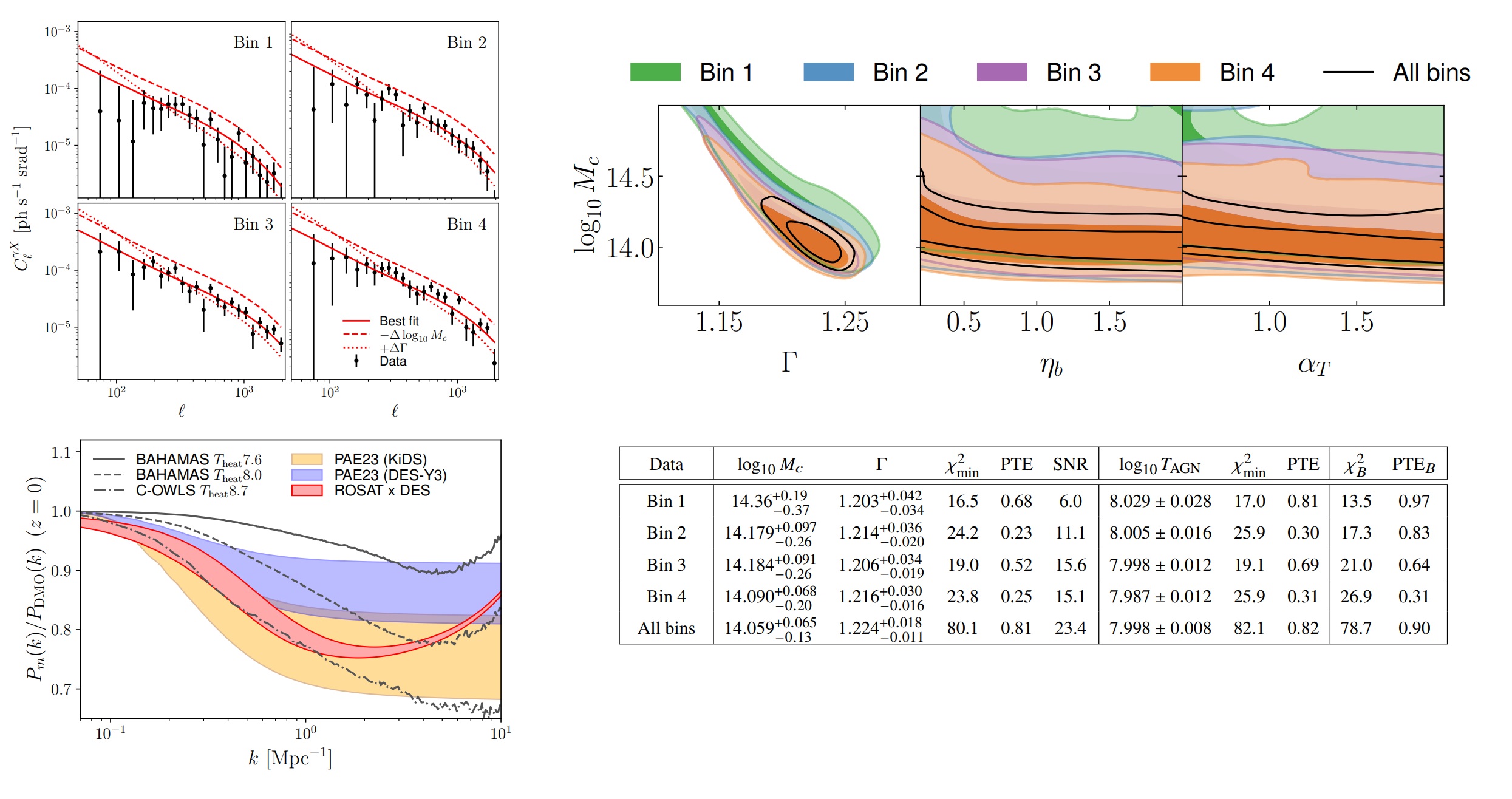 Figures and table from 2309.11129 (arxiv.org)
Figures and table from 2309.11129 (arxiv.org)
My view on this starts with what Einstein said in 1916: “the energy of the gravitational field shall act gravitatively in the same way as any other kind of energy”. The spatial energy of a gravitational field causes gravity, and it isn’t made up of baryons. I apply the same thinking to dark matter, wherein a dark matter halo is in essence “denser space”. It’s there because the space in and around a galaxy has expanded less than the intergalactic space. Whilst one might expect some correlation between dark matter and hot intergalactic gas, twenty-three sigma sounds unlikely to me. I read the paper and found it dense, obscure, and full of buzzwords. As well as acronyms, graphs, and 58 references in only 5 pages. I couldn’t get to the bottom of it. If you can, please feel free to explain it to me.
Flavor Profiling the Highest-Energy Neutrinos
In all I looked at 8 articles for August. When I removed my filters I saw there were 19 in all. Given that it’s holiday season, that’s almost one per working day. Not bad. As to how useful it is, is another issue. I took a look at the July articles, including Flavor Profiling the Highest-Energy Neutrinos. Like Shania Twain said, that don’t impress me much. That’s because I think the electron is a photon in a closed path, and the neutrino is more like a photon than an electron. Or a muon. Or a tau. I was even less impressed by Long-Standing Quantum Problem Finally Solved because it was to do with quantum entanglement. (As an aside, note where Shania said “so you’re a rocket scientist”. I must get busy in the garage. LOL! But I digress). Also in July we had Black Holes Can’t Be Created by Light which I absolutely hated. I’d have to write a whole article to explain all the things in this article that are “not even wrong”, and right now, life’s too short.
Fast-moving stars around an intermediate-mass black hole in Omega Centauri
However I did like An Elusive Black Hole Comes into View. Deputy Editor Katherine Wright tells us how “observations of seven fast-moving stars at the center of a dense star cluster in the Milky Way reveal the presence of an intermediate-mass black hole”. The underlying work, by Maximilian Häberle and 17 other authors, was written up in an open-access Nature paper called Fast-moving stars around an intermediate-mass black hole in Omega Centauri. The abstract says “determining the population of these intermediate-mass black holes is an important step towards understanding supermassive black hole formation in the early universe”. I should write about that I suppose, particularly because of the JWST findings rocking the boat, and because I have a nasty sneaking suspicion that those supermassive black holes were already there. That’s one for another day. Meanwhile Häberle at al looked at the proper motion of stars, to reveal “seven stars moving at anomalously high speeds. These stars are all located within 0.26 light-years of Omega Centauri’s center and are moving so fast that, if the cluster contained no black hole, they would have escaped its gravitational grasp long ago”. Good stuff.
 Image credit: ESA/Hubble; NASA; M. Häberle/MPIA. Caption: This colored Hubble Space Telescope image shows the likely position of Omega Centauri’s intermediate-mass black hole.
Image credit: ESA/Hubble; NASA; M. Häberle/MPIA. Caption: This colored Hubble Space Telescope image shows the likely position of Omega Centauri’s intermediate-mass black hole.
Another July article of interest was First Direct Detection of Electron Neutrinos at a Particle Collider by Associate Editor Nikhil Karthik. Note this: “The FASER scientists inferred the arrival of a parent electron neutrino in the detector from the characteristic cascade of secondary electron–positron pairs and photons that envelop the trajectory of the daughter electron”. They inferred the existence of the particle that was allegedly detected. Did you get that? They didn’t detect it, they inferred it, like they inferred the W and the Z, the top quark, and the Higgs boson. Another article of interest was Dark Matter Could Bring Black Holes Together. That’s where Marric Stephens told us about work by Gonzalo Alonso-Álvarez, James Cline, and Caitlyn Dewar. It’s about merging black holes, and sadly is of interest because it’s another one where life’s too short.
A Puzzling Excess of Cosmic Deuterons
No matter, I liked the June article on A Puzzling Excess of Cosmic Deuterons. That was about the Alpha Magnetic Spectrometer on the International Space Station, which has unexpectedly detected a high number of high-energy cosmic-ray deuterons. I did not like One Field to Rule Them All which was about inflation. Ditto for Gravitational-Wave Memory May Illustrate Spacetime Symmetries. Double ditto for Colorful Primordial Black Holes.
Making Neutron-Deficient Nuclei
Then in May I was similarly unimpressed by Cosmic Strings’ Imprints in High-Frequency Gravitational Waves, A Better Way to Charge a Quantum Battery, Careful Accounting Could Reveal the Dark Sector, Quantifying Uncertainties in Quantum Simulations, Fluxonium Qubits Under Control, and Quantum Gravity Gets a New Test. But I liked Making Neutron-Deficient Nuclei. Note that there was more that I didn’t like than I liked. It was the same for April, where is disliked The Universe’s Topology May Not Be Simple, Quantum “Torch” Begins Its Relay, Quantum Machine Learning Goes Photonic, Viewing a Quantum Spin Liquid through QED, Evidence of a New Subatomic Particle, Exploring the Black Hole Population with an Open Mind, and Shielding Quantum Light in Space and Time. It was a similar pattern for March. Ditto for February with the notable exception of JWST Sees More Galaxies than Expected. Ditto for January.
The biggest issue is the raw material
All in all I think the APS Physics Magazine staff do a good job. So much so that I’ve added the website to my favourites. Whilst most of the articles are rather brief “synopsis” items, I don’t think that’s an issue. Especially for me, with good experience of accessing a paywalled paper. I’d say a bigger issue is that very few of the articles are “research news” items, concerning science not covered by the Physical Review journals. But IMHO the biggest issue is the raw material. I’d say there’s some good papers covered here, but too many papers are pants. There’s not much here to change the course of research, or inspire a new way of thinking. It is however a useful window into the field. So, taking the year from January to date, what’s been happening in physics and cosmology of late? Not much. The only thing that really floats my boat is the James Webb Space Telescope. That apart, I’d say the field is moribund. I’d also say it’s because of the same-old same-old “trouble with physics”, which is that we don’t have free speech in science. Instead we have Guardianista science. Science can’t advance because the scientific papers that challenge vested interest don’t get published. Hence the 18 Physical Review journals are a waste of time. Ditto for Nature. In similar vein websites like Physics Forums are safe spaces patrolled by thought police. As for the solution, we shall see. But I have now given up the day job, and have more time on my hands. I have retired, but not from physics. Cracks knuckles. Oh joy!
* There’s a glitch with the date parameters in the URL. If you follow my link you’ll have to re-input the custom date range.
Scientists don’t have an accurate estimate of the age or size of our universe. Degaussing the wife’s credit cards helps my savings. Feynman’s lecture on. refraction is very easy to absorb. Entanglement is misunderstood. Lasers are boring; dark matter doesn’t exist. Black holes are an ignigma. There are no strings or gravity waves (LIGO is detecting something else; whoooop. JWT sees what it can; there is much, much more. Detector output is like watching fireworks in slow motion (there goes a Black Cat!). Congratulations on being ranked #1! Do you think anyone reads my comments? Am I famous also? Peace out and hold the Fort down @ NASA.
Who’s ranked #1? Sadly it isn’t me. Yes Parish, people do read your comments. But I think dark matter does exist, and black holes are not an enigma.
Prove it. Galactic halo star orbits are misunderstood. Gravity behaves differently as distant increases. Show me any evidence for dar matter other than inference. Bet?
I can’t prove it, Parish. But note the bit above wherein Einstein said this in 1916: “the energy of the gravitational field shall act gravitatively in the same way as any other kind of energy”. It’s like the space where a gravitational field is, is “denser” than free space, this attribute tapering off with distance from the central star or planet. Now take a look at https://physicsdetective.com/dark-matter/ where I say the non-uniform expansion of space along with gravitational binding and conservation of energy must surely mean that galaxies are sitting in regions denser space. Hence there’s more gravity than you might expect.
Is that not what the Yilmaz Theory of Gravity is about? An additional term to the stress energy tensor which accounts for the gravitational field only.
Maybe, Christian. I’d have to go through it properly to establish that. But I don’t think it’s what I was saying in How gravity works. I found a paper by Yilmaz, see https://www.wellesu.com/10.1007/bf02899296. He said this on journal page 951:
.
“Therefore we must show why the usual argument is not correct and must find a new interpretation to the free fall. That the argument cannot be correct can be seen from the fact that for a frame at rest in the gravitational field the space is in general curved, whereas for one in free fall it has to be flat as in special relativity”.
.
Space isn’t curved in a gravitational field, it’s “neither inhomogeneous nor isotropic”, wherein the speed of light is “spatially variable”. This causes light to curve downwards due to a refraction.
I agree. Your ansatz seems to be consistent with H. Puthoffs “Polarizable Vacuum (PV) Representation of General Relativity” which basically states that in the vicinity of matter the electric permittivity and magnetic permeability of Euclidean space are altered, which in effect leads to a variable speed of light in a gravitational field. H. Puthoffs paper on this theory is quite interesting where he shows that the PV theory of gravitation explains the red shift of light, light bending and the precession of the Mercury perihelion. According to Alexander Unzinger a similar Ansatz was proposed by R. Dicke and earlier on by Einstein himself. However, I admit that I haven’t dug into that topic any further other than Puthoffs Paper on PV Gravity and Alexander Unzingers book “Einsteins Schluessel”. What I found interesting is that Puthoffs PV approach as well as Yilmaz theory produce an exponential metric which lack the problem of singularities compared to the Schwarzschild Metric of GR. Your arguments regarding on how gravity works seems to me to be on track with R. Dicke and H. Puthoff.
Christian: Sorry to be slow replying. I’ve been writing my next article, and it was a tough one. I think my view of gravity it is consistent with Puthoff and Dicke, I mentioned them in The principle of equivalence and other myths. This started life as part of How gravity works (where I refer to Einstein’s many VSL quotes), but the overall article was way too long, so I split it. Perhaps I ought to go through what Dicke and Puthoff said in some detail. Meanwhile you might like to read my Gravity and Cosmology articles in sequence to get a clear idea of my “anzatz”, which isn’t mine. I got it from Einstein. It amazes me that modern General Relativity is so very different from what Einstein described. It seems that Peter Bergmann got rid of the VSL after Einstein died.
.
I’ve spoken to Alexander Unzinger about various things, but I haven’t read his book on Einstein’s Lost Key. Generally speaking I’ve been pushed for time in recent years. However I hope to have more free time going forward.
Interesting https://scitechdaily.com/how-a-twist-in-physics-could-change-technology-forever/
Sadly they don’t understand the electron either, Parish. An electron has chirality, a positron has the opposite chirality. That’s why they go round in different directions in a magnetic field. As per the bubble-chamber pictures.
Reminds me of a Queensryche song. “Who do you trust when everyone’s a crook” Revolution Calling MAGA 2024!
https://www.iflscience.com/what-is-tired-light-the-theory-that-denies-the-big-bang-75931 this sounds plausible w/p violating conservation of energy. The speed of light varies; what’s incorrect to assume lost energy from TL isn’t coverted into “dark energy” or space itself.
Man Alive you’ve been busy Boss ! First, congrats on retirement, you definitely will enjoy the extra gardening time for sure. Also check your PayPal, fresh funds for your next batch of much needed “carpel tunnel medication” should soon be available.
Joy! A thousand thanks Greg.
Wait, what??? You quit NASA? Going back to England? Good God brother have you lost your mind? I like Pink Floyd but shit, the whole European scene sucks since I left the Red revolution in Italy ’74. Good luck my friend. You need a bigger pond btw. Peace, Love, & Ammo.
What’s this Parish? I didn’t quit NASA. I’m an English guy. I dislike the EU, because they govern via diktat, and they despise democracy as mere “populism”. I’m not happy with our current government either, because they’re a bunch of champagne-socialist Marxists who despise the blue-collar workers. And the middle class. In addition I’m not happy with the previous government because they were a bunch of globalist fatcat wokesters who betrayed their voters on just about everything. But nevermind that, please can we try to stick to physics here?
I apologize for the diarrhea comments bit fair warning; word is Trump is sending our migrants to the EU and pulling out of NATO. Putting won’t want the headache. U.S. saves billions every year.
Congratulations on your retirement. Keep up the good work.
Thanks Dave. I will have more time for physics now.
John, could you please explain the plasma disruption process when they shut down a fusion reactor to me. I can’t seem to wrap my head around the idea that they just let it cool; and it goes away or something.
Parish: I’m afraid I don’t know about that. Can I mention that I’m not a fan of “Big Science” tokamak fusion, or the way that star-in-a-jar-fusion gets no publicity, or the way that too many people sneer at cold fusion. An arc welder fuses two pieces of metal using white heat and no pressure. A blacksmith fuses two pieces of metal using red heat and pressure provided by hammering. A cold welding machine fuses two pieces of metal using no heat and lots of pressure. I think the same could apply to atomic fusion.
I encounter cold fusion (in my head) every time I have to talk to artificial intelligent that can’t pass the Turing test. On side note, climate change is not a hoax, it’s real check it out: https://www.livescience.com/space/astronomy/nasa-discovers-planet-wide-electric-field-around-earth-thats-shooting-bits-of-our-atmosphere-into-space
Parish: I think the threat of climate change is exaggerated. I also think a much bigger issue is population growth in the third world. Usually in dog-eat-dog countries where the people don’t give a damn about their slash and burn agriculture, destroying the grazing with too many goats, eating endangered wildlife, throwing their trash wherever they like, and taking whatever they can off other people. These people are harming the environment in their own countries, and putting a lot of CO2 into the atmosphere. But the people who promote climate change (who usually travel by private jet and motorcade) try to censor it. I don’t know if you recall, but a few years ago there was a big push to stop people in Western countries discarding plastic bottles. One advert in the campaign showed a beach strewn with plastic bottles. If you were sharp you would notice the palm trees behind the beach. It wasn’t a beach in a country like the UK or the USA. It was a third world beach.
I’m really glad I stumbled on your blog. I haven’t hung out with somebody who thinks like me in a long time. Today i’m turning sixty and just got over cancer, and i’m really looking forward to the next forty years of my life. Let’s expose them for who they are.
Good stuff Parish, and thanks. But you made a mistake there. You’re really looking forward to the next sixty years of your life.
Elon & I have plan my friend.
Parish Bro, see my post on The Tomorrow Wars……….
“That means they never met, and were not entangled.” … No wonder the author never made it on the hook-up circuit … you have to get there at the same time to hook-up.
Entanglement is not real friend. Spin up, spin down; yes. Entanglement, no. Spooky….
No searching as magnetic monopoles, either
You can’t cut a magnet in half
This might be interesting, I don’t have access though so can’t vouch for it.
.
Search for the Anisotropy of Inertia Using the Mössbauer Effect in Fe57
Sherwin 1960
Steve: here it is: https://www.wellesu.com/10.1103/physrevlett.4.399
Congrats on the retirement John, I wish you many healthy years ahead of you. Looking forward reading more interesting articles.
Since you have time now, I would like to bring your attention to the recent videos of Jeroen Huygens, I mentioned him before , he makes great content, and for sure he is no bullshitter:
First is the propagation of light, it get interesting from halfway because there is the anisotropy of speed of light in space. This is also why I think the aether is like an elastic medium and I think about it like a 3D structure (I am still convinced it is something like something like a cubic and rhombic dodecahedron tessellation (it can morph in between the two states, and that is actually the excitation we call light or energy):
https://www.youtube.com/watch?v=tVm2Cvy6UEY
And I always wondered how we measure single photons, and his latest video is about that, a second part will also come:
https://www.youtube.com/watch?v=5V8VCFkAd0A
I have a feeling maybe I have to reach out to him regarding the whole entanglement scam, I think he can show it is not real.
Thanks Raf. I will check them out. Is Jeroen any relation to Christian Huygens? Einstein referred to Huygens when he was talking about the speed of light varying with gravitational potential, see this for example:
.
https://einsteinpapers.press.princeton.edu/vol3-trans/399
Actually now I realise his channel name is in honor of the great Chirstiaan Huygens who first came up with the wave nature of light. Since he is also from Holland I assumed he was also called that :-), but I dont think they are related. People like them we unfortunatly dont have many around anymore. It seems humanity has grown in numbers, but not in intelligence (we go backwards, and if you are interested in where it goes, there is a funny movie Idiocracy about it…)
Seems Newton got the upper hand at that time and it took untill Fresnel his ideas where accepted, far after his death.
He also has a video about visit to ASML which is in Eindhoven and as you know that is amazing technology (but controlled by US), and the reason why we have supercomputers in the palm of our hands. Since he bought a fully working photomultiplier for 100 bucks online he could actually redo the Aspects experiment but this time with regular photons that are not entangled (but of course with same or opposite polarity) to show it give the same results.
On more to keep you busy: https://www.youtube.com/watch?v=NBZmifvDJ58
This is in alignment how you see gravity I believe. Don´t get upset with the typical graph explaining gravity in the beginning, he goes a completely different route, because he is expert in optics. He calls it a gravitational index of refraction, which of course is not homogeneous through space and thus the speed of the light is not constant…
I watched it Raf, and sent Jeroen an email. He will be pleased to know that Einstein spoke about the refraction of light by a gravitational field, and referred to Huygens too.
https://retractionwatch.com/
I keep forgetting to post this blog; I find it fascinatingly great so far.
Even the basic Wikipedia search on academic fraud produces a staggering amount of data !
You may find this interesting!
.
https://pubs.aip.org/aip/apr/article/11/3/031411/3306444/Observation-of-resilient-propagation-and-free
.
Steve, I needed to know more about Wartharth-Nouchi ? And am still cornfused by the whole of the article. I did understand the basics of the electromagnetic version of a vortices producing sonic canon and the basics of most of the wave reactions. Just can’t comprehend any maths as usual…….
So here is a companion article .
https://arxiv.org/abs/2102.03636
RE : Hellwarth-Nouchi
RE: Aren’t they just describing a cavity magnetron or something simular, but trying to apply into a supposed 2D scenario for better applications??
Greg, I wish I understood that stuff. I simply recognized a topic that would resonate here .
John, I finally found a description of black hole physics i can begin to wrap my head around. I’ve always resisted the concept of a singularity. This article makes me consider other possibilities. Thoughts? If spacetime is warped this way all the way up to the event horizon the “funnel” really can’t be viewed as the traditional V funnel I.M.O. https://www.astronomy.com/science/how-can-a-black-hole-pull-light-into-itself/
It’s total garbage Parish. You have to read https://physicsdetective.com/how-gravity-works/. A gravitational field is a place where space is “neither homogeneous nor isotropic” and therefore a place where the speed of light is “spatially variable”. That;s what Einstein said. A horizontal wave in the guise of a photon travelling through such space curves downwards, just like any wave curve downwards when there’s a vertical gradient in wave speed. Then an electron, which IMHO is a photon in a closed path, falls downwards because the horizontal element of the closed path curves downwards, and the closed path ends up like this:
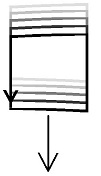
.
.
Edit: vertical gradient in wave speed, not horizontal.
Hey Boss, as usual we need your expert clarifying opinion on this brouhaha about Hogwarts-Neitzche & their super duper simular to a cavity magnetron contraption .
Greg
.
I see it: https://harvest.aps.org/v2/journals/articles/10.1103/PhysRevE.54.889/fulltext#:~:text=Focused%20one-cycle%20electromagnetic%20pulses.%20R.%20W.%20Hellwarthmeh
.
My opinion is thus: meh.
LOL! 👁💩👀 ; thanks.
https://physicsworld.com/a/air-powered-computers-make-a-comeback/
Wowsers, a Steam Punk Computer ?!?